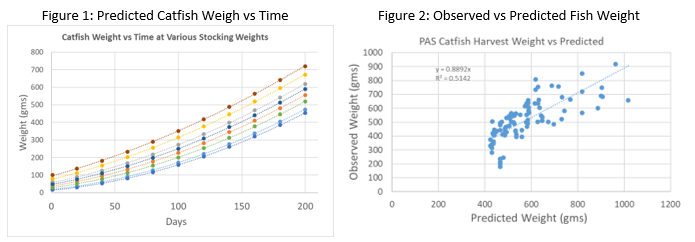CHANNEL CATFISH PRODUCTION IN THE PARTITIONED AQUACULTURE SYSTEM
Over a six-year period, channel catfish (Ictalurus punctatus) were grown in Clemson University's Partitioned Aquaculture System (PAS). Catfish fingerlings (20 - 100 gm) were stocked as size-sorted cohorts within three individual cells in each of six 1/3-acre prototype PAS raceways. Fish were fed to satiation twice daily with commercial 32% protein floating feed, with typical growing seasons averaging 160 - 190 days. Each cohort average weight was determined at stocking and harvest, with cumulative feed consumption of each cohort recorded daily. In addition, morning and afternoon dissolved oxygen, pH, total ammonia nitrogen, secchi disk visibility and water temperature were recorded daily.
Equations predicting feed consumption vs fish weight (Figure 1) and FCR vs fish weight were derived from a range of estimated values presented in Lovell (1998). These equations were used to predict growth of stocked fingerlings vs time under optimum growing conditions (Figure 2). Observed PAS harvest weights averaged 89% of predicted fish weights. However, there was substantial variation from predicted weights, resulting in an R-value of 0.51. The six-year, pooled average FCR for PAS grown catfish was 1.6.
In an effort to improve correlation between observed and predicted harvest weights, Aranguren (2004) incorporated fish-feeding rate correction factors to account for variation in environmental factors. Adjusted theoretical models yielded a smaller SSE (squared sum of errors) than statistical regression models. Variation in seasonal water temperature accounted for 95% of the impact of environmental variables influencing both models.
Previously presented estimates of catfish feed uptake and FCR were used to provide projections of catfish growth in the PAS. Introduction of temperature correction factors can improve accuracy of such projections. However, additional factors driving significant variation between observed and predicted catfish growth remain unidentified.
